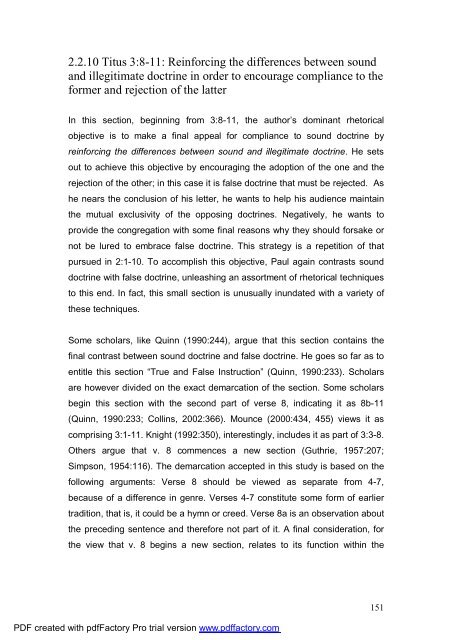A Text centred rhetorical analysis of Paul's Letter to Titus
A Text centred rhetorical analysis of Paul's Letter to Titus
A Text centred rhetorical analysis of Paul's Letter to Titus
Create successful ePaper yourself
Turn your PDF publications into a flip-book with our unique Google optimized e-Paper software.
2.2.10 <strong>Titus</strong> 3:8-11: Reinforcing the differences between sound<br />
and illegitimate doctrine in order <strong>to</strong> encourage compliance <strong>to</strong> the<br />
former and rejection <strong>of</strong> the latter<br />
In this section, beginning from 3:8-11, the author’s dominant <strong>rhe<strong>to</strong>rical</strong><br />
objective is <strong>to</strong> make a final appeal for compliance <strong>to</strong> sound doctrine by<br />
reinforcing the differences between sound and illegitimate doctrine. He sets<br />
out <strong>to</strong> achieve this objective by encouraging the adoption <strong>of</strong> the one and the<br />
rejection <strong>of</strong> the other; in this case it is false doctrine that must be rejected. As<br />
he nears the conclusion <strong>of</strong> his letter, he wants <strong>to</strong> help his audience maintain<br />
the mutual exclusivity <strong>of</strong> the opposing doctrines. Negatively, he wants <strong>to</strong><br />
provide the congregation with some final reasons why they should forsake or<br />
not be lured <strong>to</strong> embrace false doctrine. This strategy is a repetition <strong>of</strong> that<br />
pursued in 2:1-10. To accomplish this objective, Paul again contrasts sound<br />
doctrine with false doctrine, unleashing an assortment <strong>of</strong> <strong>rhe<strong>to</strong>rical</strong> techniques<br />
<strong>to</strong> this end. In fact, this small section is unusually inundated with a variety <strong>of</strong><br />
these techniques.<br />
Some scholars, like Quinn (1990:244), argue that this section contains the<br />
final contrast between sound doctrine and false doctrine. He goes so far as <strong>to</strong><br />
entitle this section “True and False Instruction” (Quinn, 1990:233). Scholars<br />
are however divided on the exact demarcation <strong>of</strong> the section. Some scholars<br />
begin this section with the second part <strong>of</strong> verse 8, indicating it as 8b-11<br />
(Quinn, 1990:233; Collins, 2002:366). Mounce (2000:434, 455) views it as<br />
comprising 3:1-11. Knight (1992:350), interestingly, includes it as part <strong>of</strong> 3:3-8.<br />
Others argue that v. 8 commences a new section (Guthrie, 1957:207;<br />
Simpson, 1954:116). The demarcation accepted in this study is based on the<br />
following arguments: Verse 8 should be viewed as separate from 4-7,<br />
because <strong>of</strong> a difference in genre. Verses 4-7 constitute some form <strong>of</strong> earlier<br />
tradition, that is, it could be a hymn or creed. Verse 8a is an observation about<br />
the preceding sentence and therefore not part <strong>of</strong> it. A final consideration, for<br />
the view that v. 8 begins a new section, relates <strong>to</strong> its function within the<br />
PDF created with pdfFac<strong>to</strong>ry Pro trial version www.pdffac<strong>to</strong>ry.com<br />
151

















